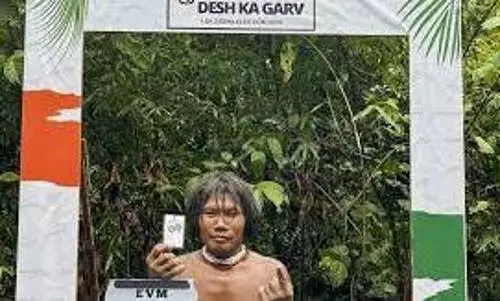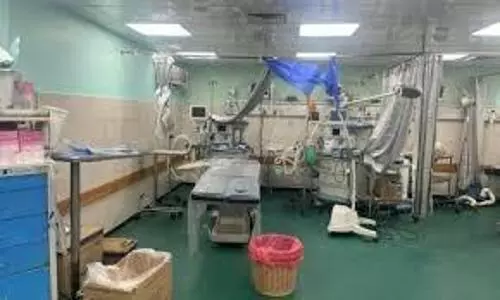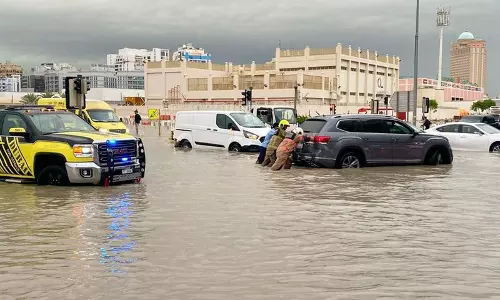
Let the wounds heal: and let us move forward
text_fieldsThe consequences of the atrcious February 14 attack on a huge convoy of CRPF at Lethpora in South Kashmir's Pulwama district are as colossal as the attack itself. It shook up the politics and strategic outlook of the country in the same manner as it shattered the ground around the length and breadth the blast site. Never has it happened in the history of three decades of Kashmir insurgency that a single attack inflicted more than 40 fatal casualties to the security forces. The backlash of the killings is equally significant and somewhat orchestrated.
The attack occurred at a time when the Lok Sabha elections are just three months away and the country's political stakeholders are weighing options on whether to repeat the Narendra Modi regime another term or introduce an alternative.
The Pulwama attack has takers on both sides. Modi's adversaries project the blast as the utter failure of the government to put curbs on the activities of militants despite launching a tough offensive including 'surgical strike' and Operation AllOut. But at the culmination of this offensive, the militants struck with vengeance. The attack has the seal of Pakistan-based Jaish-e-Mohammed that re-established its base in Kashmir after having been completely decimated in early 2000s. Worse, the fidayeen strike was carried out by a local youngster, 21 year old Adil Ahmad Dar, pointing toward a dangerous trend in the new age militancy that intensified after the death of Hizbul Mujahideen commander Burhan Wani.
But the attack also offered an opportunity to the Narendra Modi-led government to shift the public focus towards the all-important national security. The government, plagued with downward spiral on account of failed demonetization initiative or corruption hit Rafaele defence deal, would not hesitate to bring the national security to public discourse. This is why Modi in his first reaction to Lethpora attack referred to public anger, offered long rope to security forces to deal with terrorism and threatened the perpetrators of terror of dire consequences.
The immediate fallout of Modi's reference to public anger was an orchestrated campaign against common Kashmiris in several parts of mainland India. The ferocious campaign started from J&K's winter capital Jammu where mobs comprising saffron workers attacked Kashmiri government employees, students or local Muslim residents. There were pitched battles at several places despite imposition of curfew. The mobs encircled colonies of Kashmiri employees and threatened them to vacate the city. The attacks soon spread to places in Bihar, Delhi and Dehradun sending shivers down the spines of thousands of Kashmiris temporarily living outside the Valley for trade, employment and education or simply holidaying to avoid the severe chill and distressed life without the basic amenities.
Dar' s unjustified act has been condemned in severest terms. However, his sensational act to blow himself up does not make the entire Kashmiri community responsible for it. The corporate media added fuel to the utterances of the nationalist political class to identify targets. This led to a sustained and coordinated campaign against the Kashmiris in several parts of the country. The campaign has many similarities with the post-Godhra pogrom in Gujarat that resulted in return to power of Narendra Modi back then. Unleashing a rein of terror on Kashmiris at this juncture has an underlying message and objective.
Instead of directing ire towards defenceless Kashmiris, the government should have taken action against Pakistan that harbours Jaish chief Masood Azhar and offers backing to Adil Dar-like militants. Interestingly, the government did not exhibit enough grit on that count. The withdrawal of most favoured nation status is not deemed to be a severe action against the country. Unlike a controversial surgical strike in the aftermath of Uri attack, this time defence experts were expecting strong and credible action to make Pakistan sit up and take note. However, there seems to be no such urgency on the ground. The war is largely fought in the TV studios with ample reinceforcement from the political leadership. The war rhetoric is the only requirement for them to set a stage for elections.
This war-mongering has its own drawback on the ground in Kashmir. It can create even more severe internal challenge. The population in Kashmir, perpetually pushed to the wall, may respond in a different way should there be any actual escalation. This can jeopardise the gains achieved at the counterinsurgency front. Last year more than 350 militants were killed and security forces were gradually gaining the upper hand.
Modi and his home minister Rajnath Singh's tough posturing in pursuit of militants in Kashmir has not come as a surprise. Common Kashmiris, especially natives of the southern region, say that they have been left in a state of war since 2016 and there is nothing worse they have not faced. They suspect that the new campaign would add to their miseries and further narrow down chances of reach out and deescalation in hostilities.
Interestingly, the new campaign trained its guns on separatist political leadership that has been under constant pressure from the Modi-led government. On February 17, the government withdrew security of at least four Hurriyat leaders. These leaders however insist that they had never requested for security and it was provided to them on the basis of the government's own assessment of threat to them. Earlier, the government used NIA to round up separatist leaders. Even though the NIA failed to establish cases of terror funding against these separatist leaders, the action against the jailed leaders has lost relevance and faded from public memory. Withdrawal of security looks like a fresh crackdown on them.
This campaign may offer some electoral gains to the BJP but it is bound to boomerang on the larger narrative on Kashmir. A former nothern commander of the Indian army Lt Gen H S Panag wrote that, in future, terrorists are more likely to opt for indirect attacks in the form of fidayeen bombers wearing explosive belts or using explosive laden vehicles; improvised explosive devices (IEDs) and bombs planted with timers or remote triggering devices; “mowing down” of crowds using heavy vehicles; shooting down of commercial and military aircraft and helicopters with shoulder-fired missiles; exploding fuel/gas tankers in crowded areas; aerial attacks with “drone bombs”; and chemical/biological weapons. This is a scary prospect.
If these apprehensions are genuine, the situation in Kashmir is going to worsen further. The state is reeling under a state of anarchy. For the past eight months, the affairs of the state are run by the Delhi-appointed Governor who doesn't miss a single occasion to disparage the population and their leadership. The Governor has been given full authority to change the adminsitratve structure of the state. In his latest decision he separated Ladakh region from Kashmir by creating a separate division for Ladakh. The decision is seen as a perpetual campaign to disempower Kashmir.
Kashmir has been brought to this pass through a series of follies that includes the lack of political will to resolve the issue. There was a time, not very long ago, when the militancy had almost been wiped out of the Valley. The things have taken a complete turnaround now. The pro-India politics that gained a huge currency after 2002 stands irrelevant because of the complete failure of the PDP-BJP coalition. The conflicting ideology of the two parties prevented them from being accommodative. The PDP bore the brunt and is on the verge of collapse. Lack of any political initiative and on the other hand, the iron fist policy against the people led to the depressing situation where we find the state now. People's indifference to the mainstream politics can be gauged from their response to panchayat and municipal polls held last year.
Kashmir should not be handled for political and electoral gains. The region requires deeper and serious political intervention and reach out to the beleaguered population. Delay in such a response can lead to more dastardly acts like in Lethpora. The youngsters have lost hope and it can't be regained through suppression and persecution. Kashmir requires a healing touch, not war mongering.























